Hull-House Incorporated
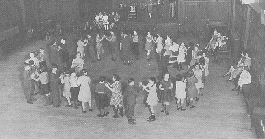
IV. Production

Hull-House was an educational institution akin in some regard to a factory production. Recent immigrants were educated in the American way. At one point, Hull-House numbered thirty-five college trained men and women (Bryan and Davis,103) who in turn shared their wealth of knowledge with immigrant participants. Settlement reform meant changing the persons that one encountered. In conjunction with this philosophy, overcoming the boundaries separating cultures and classes lay in
"the vicarious power of contact,...through local interactions and daily conversations, participants would generate more equitable and relational methods of negotiating American diversity" (Jackson, 14). To accomplish this task, a plethora of classes and workshops were ongoing. Everything from art and music classes to wrestling and gym classes ensured the complete and total re-education of an individual.
 Addams and Dewey were not in agreement with parents who wanted to send their children to ethnic schools to learn the language and traditions of their mother country.
Addams and Dewey were not in agreement with parents who wanted to send their children to ethnic schools to learn the language and traditions of their mother country. 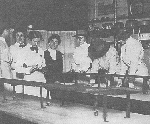 Addams praised schools that were "socializing and harmonizing factors in neighborhoods inhabited by the foreign born" (Lissak, 49). According to Ms. Addams a school should transfer "a culture so wide and deep and universal" (Addams, as quoted in Lissak, 54-55)that the child could incorporate,and at the same time cut loose from, the provincial culture of his or her parents. Democracy to Addams meant respecting one other's cultures while also stressing the unifying aspects. The Abbott sisters and Sophia Breckinridge, all influential Hull-House residents, believed that mastery of English and high American culture meant a greater participation in the "valuable products of American civilization" (Lissak, 50). Manufacturing immigrants into an Americanized production would ensure that these new citizens could enjoy other American products. If recent immigrants continued to segregate themselves into ethnic enclaves, then their socioeconomic status would not rise. In some cases, success was apparent, as when one former Hull-House resident said she could never have married someone of her husband's stature if it wasn't for her transformation at Hull-House (Polacheck). Addams praised schools that were "socializing and harmonizing factors in neighborhoods inhabited by the foreign born" (Lissak, 49). According to Ms. Addams a school should transfer "a culture so wide and deep and universal" (Addams, as quoted in Lissak, 54-55)that the child could incorporate,and at the same time cut loose from, the provincial culture of his or her parents. Democracy to Addams meant respecting one other's cultures while also stressing the unifying aspects. The Abbott sisters and Sophia Breckinridge, all influential Hull-House residents, believed that mastery of English and high American culture meant a greater participation in the "valuable products of American civilization" (Lissak, 50). Manufacturing immigrants into an Americanized production would ensure that these new citizens could enjoy other American products. If recent immigrants continued to segregate themselves into ethnic enclaves, then their socioeconomic status would not rise. In some cases, success was apparent, as when one former Hull-House resident said she could never have married someone of her husband's stature if it wasn't for her transformation at Hull-House (Polacheck).
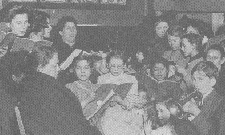 Besides the regular residents, thousands of neighbors passed through the Hull-House doors on a weekly basis to participate in activities from the traditional to the more radical. Classes were conducted on art, music, literature, drama Besides the regular residents, thousands of neighbors passed through the Hull-House doors on a weekly basis to participate in activities from the traditional to the more radical. Classes were conducted on art, music, literature, drama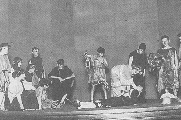 and philosophy.
Physical education, in addition to the mental education, ranked in importance at Hull-House. Residents set up a wrestling team, a basketball team, and a gym class. Volunteers lectured on topics such as socialism and women's suffrage. Some neighbors came to use the free bath facilities at Hull-House until Jane Addams pushed for the government to build public baths in order to aid in city sanitation. and philosophy.
Physical education, in addition to the mental education, ranked in importance at Hull-House. Residents set up a wrestling team, a basketball team, and a gym class. Volunteers lectured on topics such as socialism and women's suffrage. Some neighbors came to use the free bath facilities at Hull-House until Jane Addams pushed for the government to build public baths in order to aid in city sanitation. 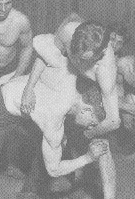 Some groups picketed unfair labor practices. Hull-House even had a coffee shop (Stebner,12). Some groups picketed unfair labor practices. Hull-House even had a coffee shop (Stebner,12).
Performance and reform have the same etymological history with both roots meaning to bring into being. 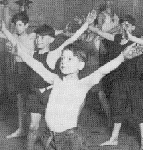 (Jackson,8). Reform was thought to partially transpire through varying kinds of performances that occurred daily at Hull-House. Students performed Shakespeare, concerto, and dances all in the hopes of distancing them from the slum life. While settlement workers watched their students' artistic creations, they hoped they were forming new creations out of their students, aiding immigrants in an identity formation process. As student produced, they were participating in a production process themselves.
Ultimately, critics argued that Hull-House was only influential among those immigrants who were fascinated with American culture and willing to leave their past cultural identities behind and assimilate into the American mainstream. (Jackson,8). Reform was thought to partially transpire through varying kinds of performances that occurred daily at Hull-House. Students performed Shakespeare, concerto, and dances all in the hopes of distancing them from the slum life. While settlement workers watched their students' artistic creations, they hoped they were forming new creations out of their students, aiding immigrants in an identity formation process. As student produced, they were participating in a production process themselves.
Ultimately, critics argued that Hull-House was only influential among those immigrants who were fascinated with American culture and willing to leave their past cultural identities behind and assimilate into the American mainstream.
|